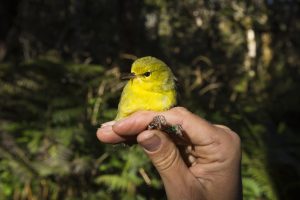Maui ʻAlauahio
Names
- ʻŌlelo Hawaiʻi: Maui ‘Alauahio
- Common: Maui Creeper
- Scientific: Paroreomyza montana newtoni
Song
Conservation Status
- State Recognized as Endemic
- NatureServe Heritage Rank G4—Apparently Secure
- IUCN Red List Ranking—Endangered
Species Information

Maui ʻalauahio or Maui creeper bird banding. PC: MFBRP, UH PCSU
The Maui ‘alauahio, or Maui creeper, is a small insectivorous Hawaiian honeycreeper (Family: Fringillidae) endemic to Maui. A subspecies (Paroreomyza montana montana) occurred on Lāna‘i but was last seen in 1937 and is presumed to be extinct. Adult males are predominantly olive-green above and have a bright yellow face, throat, and belly; the amount and intensity of yellow varies among individuals. Adult females are similar, but generally not as bright; both have short, fine straight bills. Adult plumage is not attained for several years. The Maui ‘alauahio gleans invertebrates from woody and leafy parts of a variety of plants. Adults defend 1 to 2 hectare (2.5 – 5 acre) home ranges against conspecifics year-round and will chase ‘apapane (Himantione sanguinea) and Japanese white-eyes (Zosterops japnicus) from the vicinity of their nests. They are socially monogamous and pair for life, although extra-pair copulations have been confirmed through genetic analysis. Females choose the nest site and build open-cup nests. They lay two eggs, and birds will renest after a nest failure. Only females incubate eggs and brood nestlings. They do not breed until their third year, and young birds (i.e., helpers) associate with breeding pairs. Helpers are usually offspring from the previous year and feed the female, nestlings, and fledglings. Juveniles are fed for two to three months and remain with their parents in family groups for 18 – 20 months.
Distribution
Above 900 meters (3,000 feet) on the slopes of Haleakalā. Historically common in west Maui and on Lāna‘i; these populations are now extirpated. Fossil evidence suggests they were common across the south side of the island and in lowland forests.
Habitat
Primarily wet and mesic montane forests dominated by ‘ōhi‘a (Metrosideros polymorpha), although they also occur in subalpine māmane scrub (Sophora chrysophylla), and in dry and mesic forests dominated by pine (Pinus spp.) and eucalyptus (Eucalyptus spp.; e.g., Polipoli State Park and Hosmer Grove); all populations occur above 900 meters (2,925 feet) elevation. Habitat conditions vary greatly across the species’ range. The northeastern part of the species’ range is actively managed by the State of Hawai‘i, (i.e., Forest Reserve and Natural Area Reserve), the National Park Service, and private landowners including the Nature Conservancy. All entities are current members of the East Maui Watershed Partnership. The remainder of the species’ range occurs on State and Federally owned lands, where management efforts vary considerably.
Threats
- Predation. Introduced predators such as free-ranging cats, mongooses, and rats are a threat to many native bird species. Rats (Rattus spp.) have been observed depredating nests and females while they are incubating eggs at the nest. Female behavior of begging near nests may make them particularly susceptible to predation.
- Disease. Similar to other native forest birds, ʻalauahio are susceptible to introduced avian diseases such as avian malaria and avian pox. Susceptibility to avian malaria has been documented, and likely prevents the establishment of populations in lowland areas. In Kahikinui, few individuals show signs of avian pox, although it is prevalent in ‘amakihi (Hemignathus virens) and ‘apapane (Himatione sanguinea) also found in this area. These data are equivocal, indicating low transmission rates, possible resistance, or very high mortality for this species.
- Habitat degradation. Introduced ungulates such as pigs, sheep, and deer have altered the habitat that ʻalauahio depends on. Current fencing around protected areas is not effective in excluding axis deer (Axis axis). Currently, deer populations on Maui are growing and threaten to further degrade forests occupied by the Maui ‘alauahio.
(UH PCSU, 2021)
Plans & Projects
Additional Resources
For more information and references visit the DLNR State Wildlife Action Plan factsheets. DOFAWʻs species pages and State Wildlife Action Plan fact sheets are provided for general information and are not meant to be a citable, original source of data. If you are a student, researcher, or writer looking for a citable source, please explore the references below or find other original data sources, rather than citing these webpages. The references below were provided by the authors of the State Wildlife Action Plan fact sheets at the time of drafting:
- Baker H, Baker PE. 2000. Maui ‘alauahio (Paroreomyza montana). In The Birds of North America, No. 504 (Poole A, Gill F, editors.). Philadelphia, (PA): The Academy of Natural Sciences; and Washington DC: The American Ornithologists’ Union.
- IUCN Red List of Threatened Species. 2015. Version 2014.3. Available at: www.iucnredlist.org. (Accessed May 2015).
- Scott JM, Mountainspring S, Ramsey FL, Kepler CB. 1986. Forest bird communities of the Hawaiian islands: their dynamics, ecology and conservation. Lawrence, (KS): Cooper Ornithological Society.

